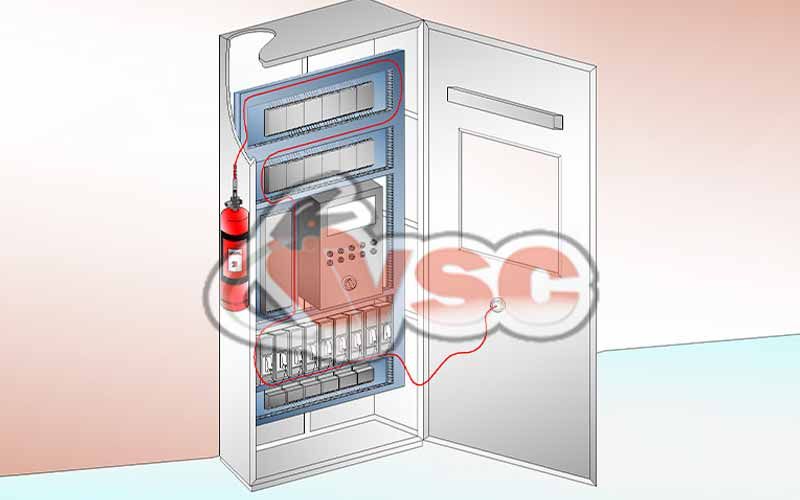In-Panel Micro Extinguishing Systems (Electricity Panel)
While it is known that fires can cause significant damage, it should also be acknowledged that they start with just a single spark. When small details are overlooked and neglected, even the tiniest ignition can lead to massive losses. The installation of an internal micro-fire suppression system, despite being a minimal precaution, prevents the occurrence of different types of damages both technically and structurally.
Micro fire suppression systems are installed to protect electrical installations or electronic components hidden inside panels from the risk of fire. These systems are meticulously installed and equipped with heat-sensitive tubes that instantly melt, leaving no chance for the fire to spread. In this way, they are considered one of the most effective fire suppression systems, providing optimal protection.

Just like large-scale fire suppression systems that safeguard extensive structures, fire suppression systems for panels are equally crucial. Considering that the systematic and technical infrastructure of buildings runs through panels and cable galleries, the potential consequences of any malfunction in the panel fire suppression system become evident. Micro fire suppression systems, also used in management panels for electrical equipment, ensure the protection of the entire building's IT infrastructure.
In-panel Micro Extinguishing System Design
In the design of micro fire suppression systems for panels, polymer pipes are laid along the paths of cables. These pipes consist of multiple sections that can melt, ensuring that there are no blind spots and providing the ability to respond instantly to fires, no matter where they start. It is crucial for experts in the field to handle the installation of micro fire suppression systems, and regular maintenance ensures that they remain active.
The concept of the polymer pipes acting as extinguishing nozzles at the weak points is applied based on the principle of responding to the heat generated during a fire. In this design, the tube's proximity to the panel is essential. With the logic of a sensor, as the temperature rises, the polymer pipes automatically puncture at sensitive locations, allowing the fire-suppressing agent to be released into the area emitting heat, intervening before the fire even starts.
The micro fire suppression system for panels operates on the principle of the extinguishing gas being released onto the fire before the heat reaches a dangerous level, preventing damage to the pipe and allowing the extinguishing agent to spread. This system is effective in protecting a lightweight but valuable unit. Many cable galleries and panels use tubes containing HFC 125, HFC 236, HFC 23, and FM 200 gases, ensuring the capability to extinguish electrical fires without conductivity. This eliminates the risk of health hazards for the personnel intervening in case of a fire.
In-Panel Micro Extinguishing System Prices
When it comes to the prices of micro fire suppression systems for panels, it is essential to consider the specific requirements of our customers and the size of the units where the system will be installed. The use of high-quality materials and compliance with TSE standards during production ensures that the micro fire suppression system for panels also meets international standards.
In panels that have hard-to-detect and inaccessible inner areas where manual intervention is not feasible, the necessity of an automatic system cannot be ignored. The cost of real protection should be seen as less than the potential losses incurred from fire damage and the value of the protected area. After all, it is not just the panel and its cables that are safeguarded, but the entire building and its vital mechanisms, making it crucial not to neglect fire suppression systems and not to overlook any small details.
Micro fire suppression systems for panels provide complete security for panels in machine rooms, serving the primary purpose of protecting the machinery unit and, secondarily, ensuring the safety of the entire building. Despite the name "micro," the protection it offers manifests in maximum results.
-
FM-200 Gas Fire Suppression Systems
-
Kitchen Hood Fire Suppression Systems
-
Sprinkler Fire Suppression Systems
-
Carbon Dioxide Extinguishing Systems, CO2 (What is it? How is it used?)
-
FE25 Gas Extinguishing Systems (Working Principle and Price)
-
In-Panel Micro Extinguishing Systems (Electricity Panel)
-
Clean Gas Fire Suppression Systems (How Does It Work? Gases Used?)
-
NOVEC 1230 Fire Suppression Systems (Gas)
-
Argon Gas Extinguishing Systems (INERT Gas, Turnkey)
-
Vehicle Extinguishing Systems (Tube, Maintenance)
-
Fire Detection and Warning Systems
-
Foam Extinguishing Systems



